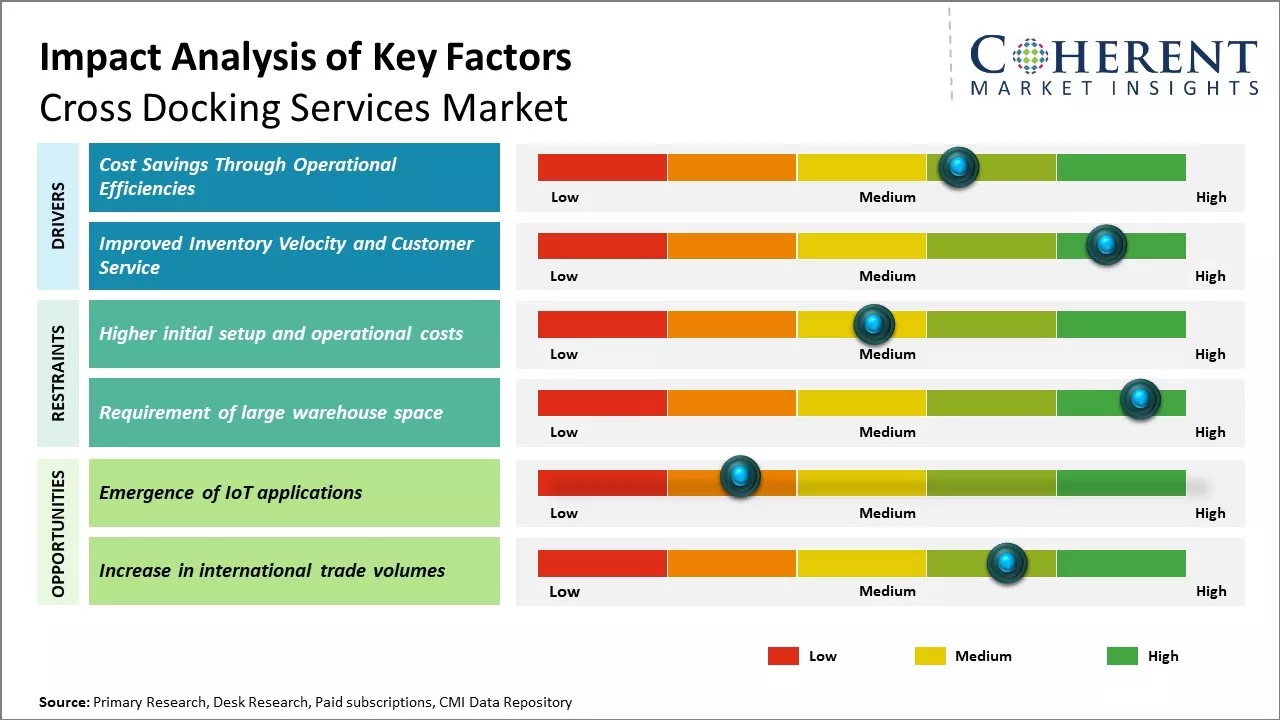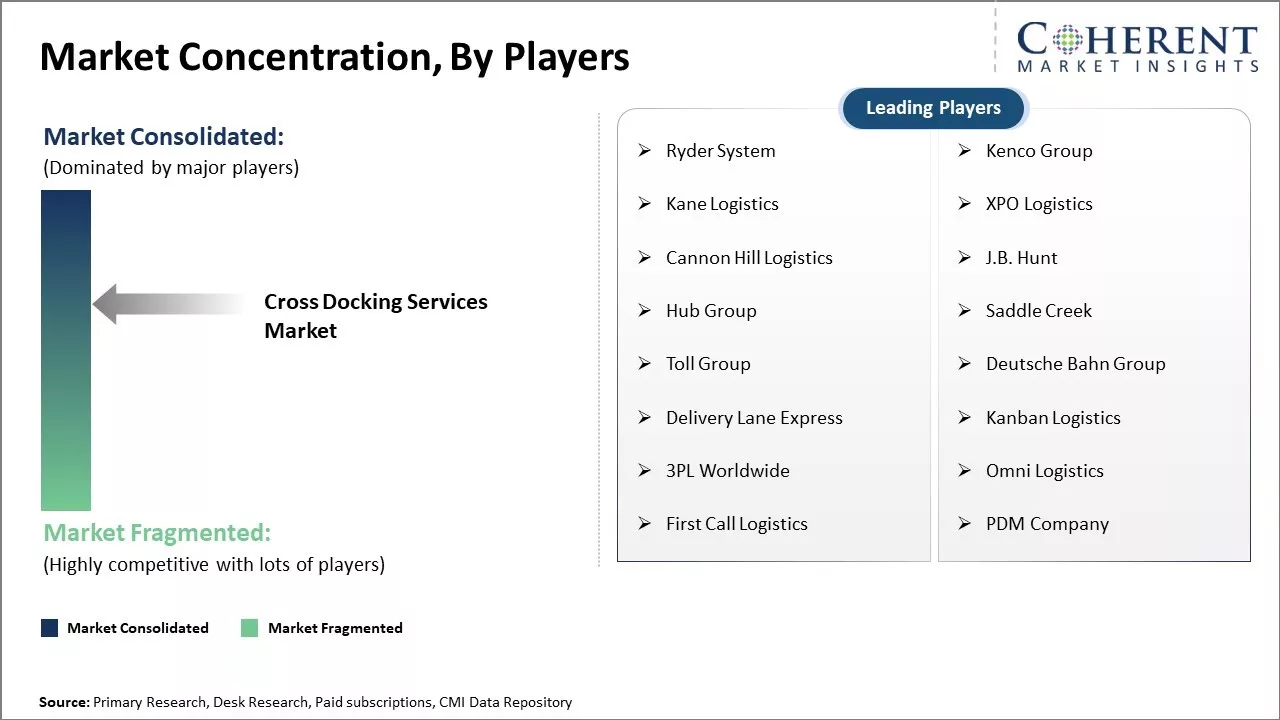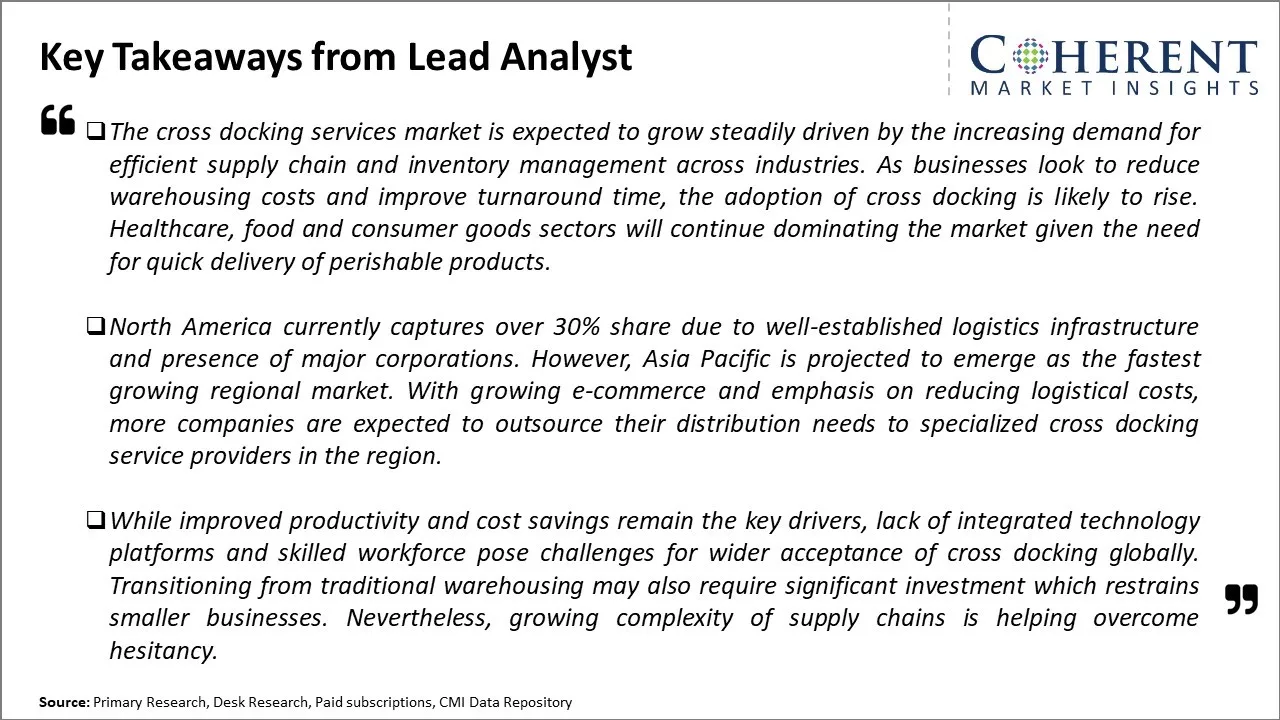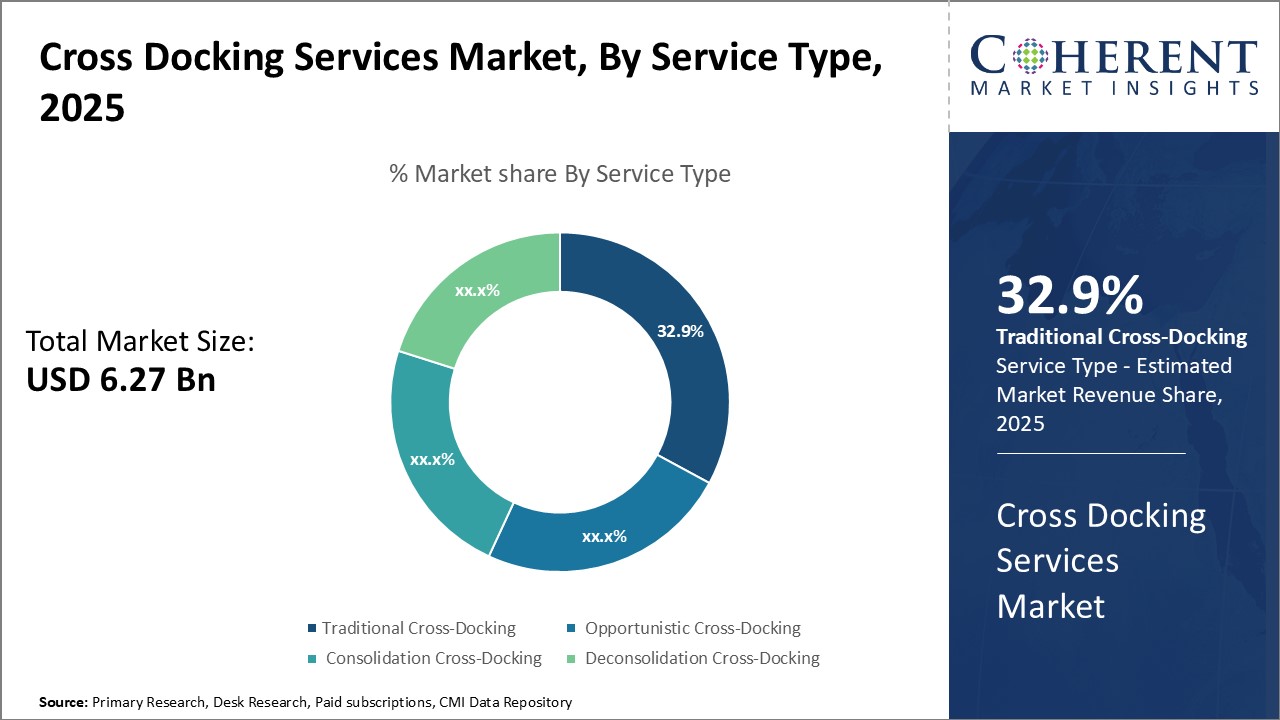Cross Docking Services Market Size and Trends
The cross docking services market is estimated to be valued at USD 6.27 Bn in 2025 and is expected to reach USD 9.43 Bn by 2032, growing at a compound annual growth rate (CAGR) of 6.0% from 2025 to 2032.

Discover market dynamics shaping the industry: Download Free Sample
Cross docking allows companies to transfer merchandise and materials from incoming to outgoing docks with little or no storage in between, thus enabling faster inventory turnover and order fulfilment cycles. The cross docking services market is driven by the need for efficient supply chain management. As e-commerce continues to grow rapidly, the demand for cross docking is increasing to enable the faster delivery of shipments to customers. Furthermore, cross docking helps companies reduce their inventory holding costs. These factors are expected to boost the adoption of cross docking services among industries.
Cost Savings Through Operational Efficiencies
Cross docking enables companies to save costs through increased operational efficiencies. By eliminating storage and handling of inventory at warehouses, cross docking reduces costs associated with warehouse operations such as material handling costs, rental costs for warehouse space, utilities, security, maintenance, insurance, etc. Transporting goods directly from receiving docks to shipping docks minimizes movement of inventory within the facility. This leads to optimized space utilization as well as labor requirements within the warehouse. Companies are able to process higher volume of goods with lesser workforce. As inventory spends very little time, sometimes just a matter of hours, at the cross docking facility, there are no costs related to storing, safekeeping, and preserving the quality of inventory for long periods. Risk of inventory damage, deterioration or obsolescence which leads to write-offs is significantly reduced.
Cross docking also helps in reducing transportation costs. By consolidating shipments from multiple suppliers, cross docking providers are able to utilize the loading capacity of trucks and trailers more efficiently. This allows them to ship in full truckloads and reduce the number of shipments. Less empty returns translate to lower mileage costs. Through route optimization, cross docking companies plan the most cost-effective routes to move shipments from suppliers to customers located across different geographical regions. Advanced warehouse management systems and analytics further enhance operational efficiencies through better resource planning and demand forecasting. This comprehensive cost reduction across the entire supply chain enables cross docking clients to price their products competitively while still maintaining healthy profit margins.
Market Concentration and Competitive Landscape

Get actionable strategies to beat competition: Download Free Sample
Improved Inventory Velocity and Customer ServiceCross docking helps companies significantly improve inventory velocity and turns. As inventory resides in the cross docking facility for a very short timeframe, often just a matter of hours, it reduces the inventory days outstanding. Faster inventory turnover allows companies to free up working capital which can be utilized for their other business needs such as expanding operations, funding new product development, etc. Companies are able to cater to the dynamic market demand more promptly due to faster inventory replenishment cycles.
With cross docking, filling customer orders from existing inventory becomes very convenient. Goods received from different suppliers arrive at the cross docking center daily and shipments are quickly sorted for direct transfer to trailers or containers heading towards customer destinations. This ensures on-time order fulfilment for customers spread across wide geographical regions.

To learn more about this report, Download Free Sample
Market Challenges: Higher initial setup and operational costsWith tight delivery schedules and complex inventory management needs, there is little room for error. Labor shortages also pose a problem as there is growing demand for skilled warehouse workers and drivers. Other challenges include finding suitable real estate with locations close to major transportation hubs and managing communication between clients, carriers and internal operations teams in real-time.
Market Opportunities: Growth of 3PL logistics sector
As online shopping continues expanding, the need for efficient order fulfillment and last-mile delivery is increasing. Cross docking helps retailers and manufacturers consolidate shipping and cut costs. Advancements in warehouse automation and data analytics also present opportunities to optimize operations, track inventory movements and meet customer expectations.

Discover high revenue pocket segments and roadmap to it: Download Free Sample
Insights By, Service Type- Demand for Time-efficient Logistics Drives Traditional Cross DockingIn terms of service type, traditional cross-docking contributes the highest share owing 32.9% in 2025 of the market owing to the ever-growing demand for time-efficient logistics operations from companies. Traditional cross docking, which involves sorting and redistributing products with little to no storage, enables distributors and retailers to significantly reduce the time required for inventory movement. This helps companies meet tight delivery timelines and stock goods on shelves much faster. As products have a shorter replenishment cycle, inventory carrying costs are also lowered. Further, companies can offer customers a wider selection of SKUs despite constraints of physical warehouse space since inventory turns are faster. Traditional cross docking utilizes the full truckload potential while optimizing the container capacity, thus maximizing transport efficiency as well.
Insights By, Technology Integration- Warehouse Visibility Drives Growth in WMS Integration
In terms of technology integration, Warehouse Management Systems (WMS) contributes the highest share of the market owing 36.9% in 2025. WMS offers real-time visibility and control over all warehouse operations through integration with scanning, sorting and conveyor systems. This enables cross docking centers to track inventory levels and locations across docks, effectively manage labor and automate workflows. Having accurate and up-to-date data assists in reducing errors, improving dock-to-stock turnaround times and meeting complex sequencing requirements. As cross docking volumes scale, the need for sophisticated tools to enhance visibility, optimize workflows, and integrate with partner systems grows significantly. This drives increased WMS deployments at cross docking facilities.
Insights By Ownership Model- Efficiency Gains Fuel Outsourcing to 3PL Providers
In terms of ownership model, Third Party Logistics (3PL) providers contributes the highest share of the market owing 62.6% in 2025. Many companies prefer outsourcing cross docking requirements to specialized 3PL players who can leverage economies of scale to optimize operations. 3PLs make sizable investments in innovative technologies, large-scale infrastructure and skilled workforce to maximize throughput while maintaining flexibility. This allows companies to benefit from higher efficiencies, lower costs, and focus internal resources on core competencies. Further, 3PL cross docking centers offer network advantages through strategic locations and multi-client utilization of docks. The operational expertise, higher levels of automation, and multimodal transport abilities of 3PLs help drive higher inventory turns and on-time deliveries.
Regional Insights

Need a Different Region or Segment? Download Free Sample
North America has established itself as the dominant region in the global cross docking services market owing 41.7% in 2025. The large presence of organized retail industry along with robust 3PL networks has propelled the cross docking services space. Major retail chains in the U.S. and Canada rely on efficient logistics to ensure just-in-time deliveries across a wide footprint of stores. Cross docking allows the timely consolidation of shipments from different distribution centers, enabling faster replenishments. It is a core part of retail logistics strategies to maintain optimal inventory levels while minimizing out of stock costs.
The automotive industry is another major adopter of cross docking in the region. With exports playing an important role, automakers leverage shared-user facilities for effective sorting and trans-shipping of inbound components and outbound vehicle shipments. This helps automotive suppliers and Original Equipment Manufacturers lower transportation costs while meeting tight production schedules. Cross docking providers have extensive experience in handling complex automotive logistics with varying part numbers and shipment configurations.
Asia Pacific has seen tremendous economic growth in recent years led by countries like China, India, and Southeast Asian nations. This has spurred domestic consumption as well as expansion of manufacturing capabilities in the region. Cross docking services have gained prominence among industries tapping into the Asia Pacific market. E-commerce companies are actively using 3PL-managed cross docking facilities to streamline fulfillment of high-volume orders across diverse customer bases. Electronics OEMs also rely on cross docking for efficient import-export movements as trade links within the region strengthen. Pricing for cross docking services is competitive due to abundant infrastructure and a skilled workforce available in major Asia Pacific markets.
Market Report Scope
Cross Docking Services Market Report Coverage
| Report Coverage | Details | ||
|---|---|---|---|
| Base Year: | 2024 | Market Size in 2025: | USD 6.27 Bn |
| Historical Data for: | 2020 To 2024 | Forecast Period: | 2025 To 2032 |
| Forecast Period 2025 to 2032 CAGR: | 6.0% | 2032 Value Projection: | USD 9.43 Bn |
| Geographies covered: |
|
||
| Segments covered: |
|
||
| Companies covered: |
Ryder System, Kenco Group, Kane Logistics, XPO Logistics, Cannon Hill Logistics, J.B. Hunt, Hub Group, Saddle Creek, Toll Group, Deutsche Bahn Group, Delivery Lane Express, Kanban Logistics, 3PL Worldwide, Omni Logistics, First Call Logistics, and PDM Company |
||
| Growth Drivers: |
|
||
| Restraints & Challenges: |
|
||
Uncover macros and micros vetted on 75+ parameters: Get instant access to report
Cross Docking Services Industry News
- In November 2023, Maersk started building a big new cold storage place in Rotterdam, the Netherlands. This special warehouse, next to the Maasvlakte II terminal owned by Maersk's APM Terminals, is 40,000 square meters and will start working in late 2024.
- In October 2023, Samskip expanded its business in the Baltic Sea area by starting a new direct short-sea service between Finland, Latvia, the U.K., and the Netherlands. They will also provide extra services like help with customs and land transport to make sure things go smoothly from door to door.
- In September 2023, C.H. Robinson opened one of the biggest logistics centers near the border in Laredo, Texas. This big place, which is 400,000 square feet and has 154 doors and space for 700 trailers, is meant to speed up trade between the U.S. and Mexico.
*Definition: Cross docking services market involves consolidating shipments from multiple suppliers and redistributing them to retailers or customers without storing the products in a warehouse for a long period of time. Through this just-in-time model, cross docking helps reduce inventory carrying costs and compress delivery lead times by eliminating non-value adding activities like double handling. Companies offering cross docking services help organizations better manage their supply chains by facilitating smooth transfer of goods from suppliers to end customers.
Market Segmentation
- Service Type Insights (Revenue, USD BN, 2020 - 2032)
- Traditional Cross-Docking
- Opportunistic Cross-Docking
- Consolidation Cross-Docking
- Deconsolidation Cross-Docking
- Technology Integration Insights (Revenue, USD BN, 2020 - 2032)
- Automated Cross-Docking Systems
- RFID Tracking Systems
- Warehouse Management Systems (WMS)
- Transportation Management Systems (TMS)
- Ownership Model Insights (Revenue, USD BN, 2020 - 2032)
- Third-Party Logistics (3PL) Providers
- In-house Cross-Docking Operations
- Industry Vertical Insights (Revenue, USD BN, 2020 - 2032)
- Retail
- Food and Beverages Sector
- Manufacturing
- Automotive
- Healthcare and Pharmaceuticals
- E-commerce
- Construction
- Others
- Regional Insights (Revenue, USD BN, 2020 - 2032)
- North America
- U.S.
- Canada
- Latin America
- Brazil
- Argentina
- Mexico
- Rest of Latin America
- Europe
- Germany
- U.K.
- France
- Italy
- Russia
- Rest of Europe
- Asia Pacific
- China
- India
- Japan
- Australia
- South Korea
- ASEAN
- Rest of Asia Pacific
- Middle East & Africa
- GCC Countries
- South Africa
- Rest of Middle East & Africa
- North America
- Key Players
- Ryder System
- Kenco Group
- Kane Logistics
- XPO Logistics
- Cannon Hill Logistics
- J.B. Hunt
- Hub Group
- Saddle Creek
- Toll Group
- Deutsche Bahn Group
- Delivery Lane Express
- Kanban Logistics
- 3PL Worldwide
- Omni Logistics
- First Call Logistics
- PDM Company
Share
Share
About Author
Gautam Mahajan is a Research Consultant with 5+ years of experience in market research and consulting. He excels in analyzing market engineering, market trends, competitive landscapes, and technological developments. He specializes in both primary and secondary research, as well as strategic consulting across diverse sectors.
Missing comfort of reading report in your local language? Find your preferred language :
Transform your Strategy with Exclusive Trending Reports :
Frequently Asked Questions
EXISTING CLIENTELE
Joining thousands of companies around the world committed to making the Excellent Business Solutions.
View All Our Clients
